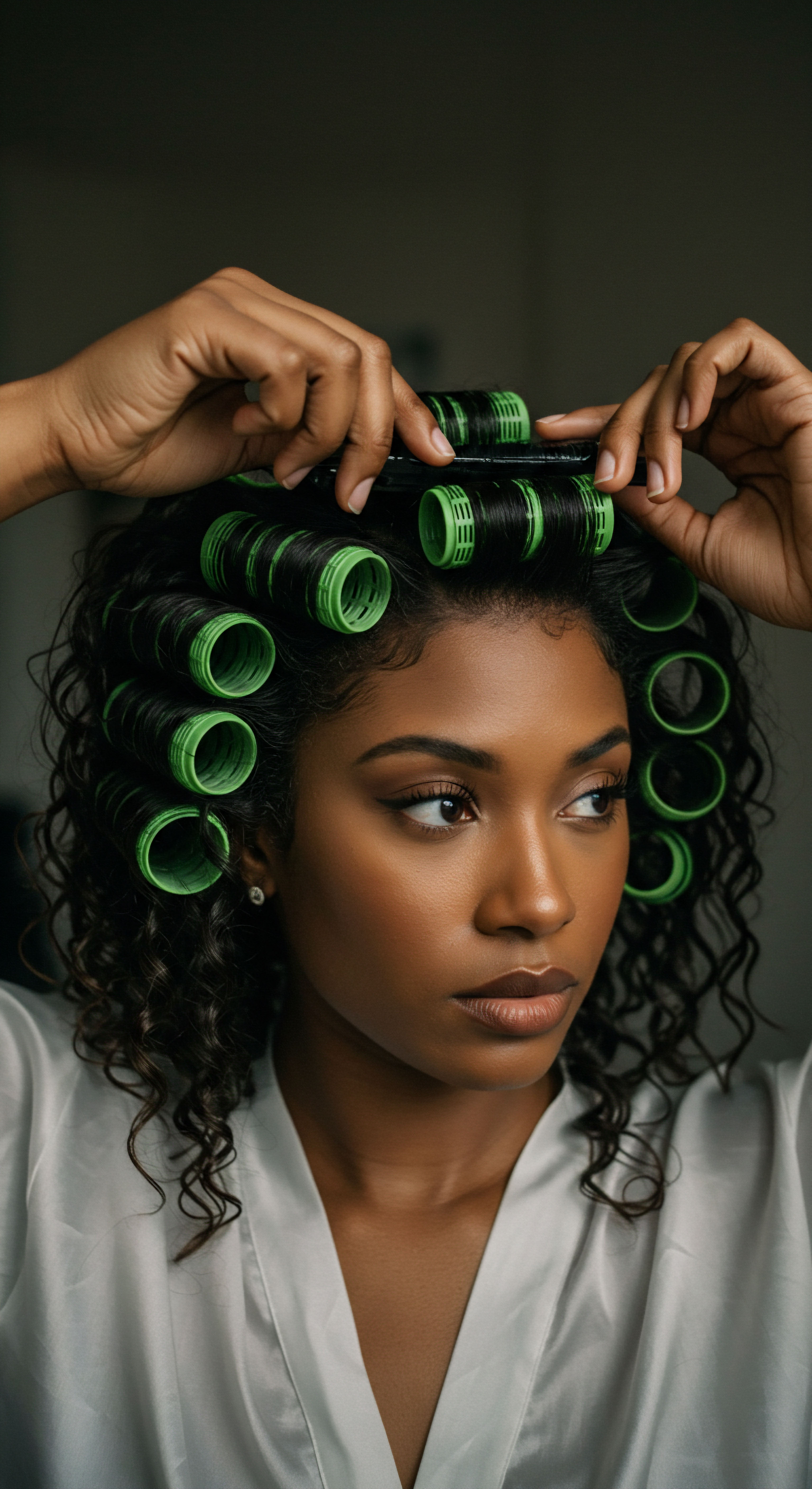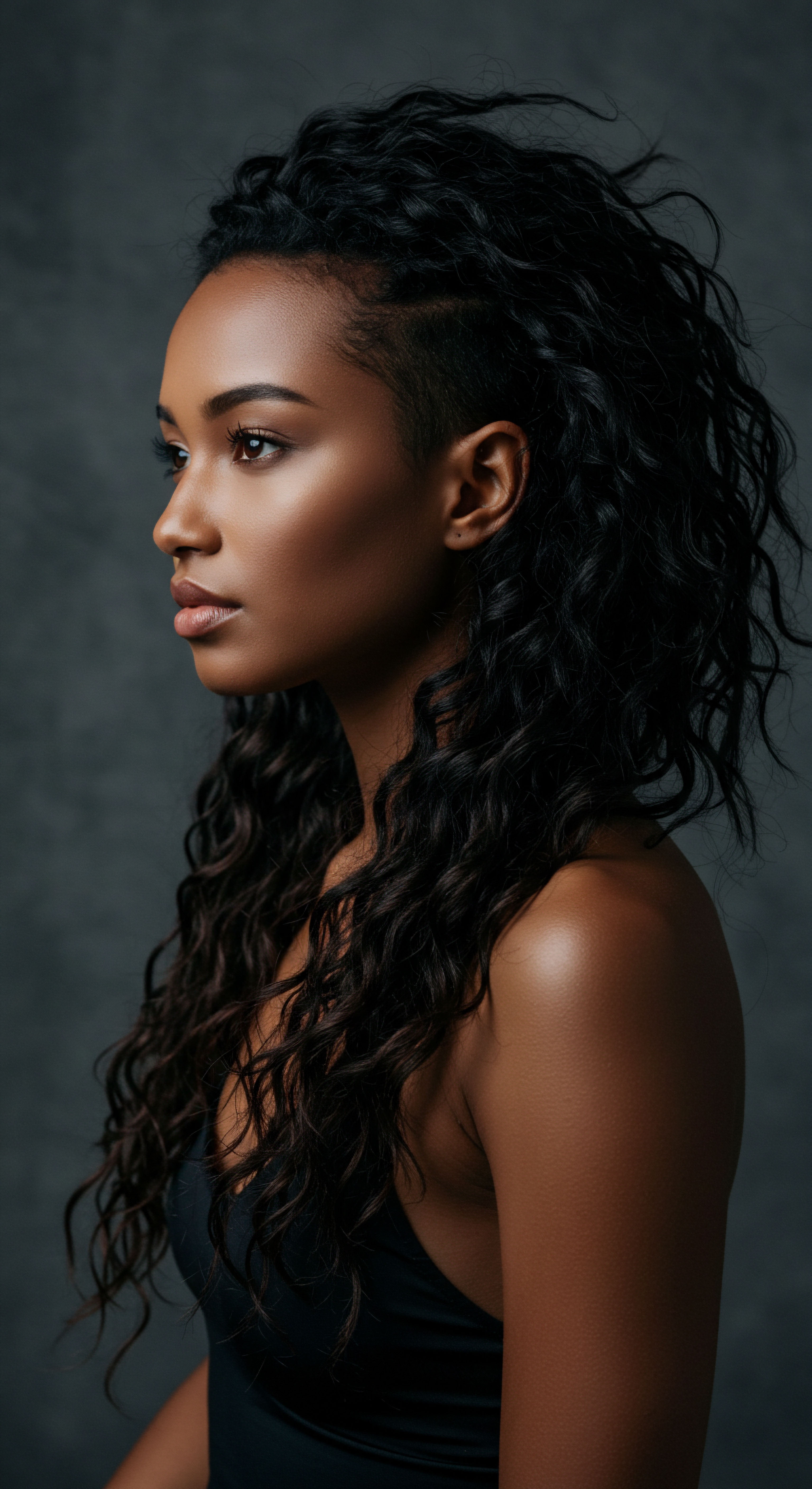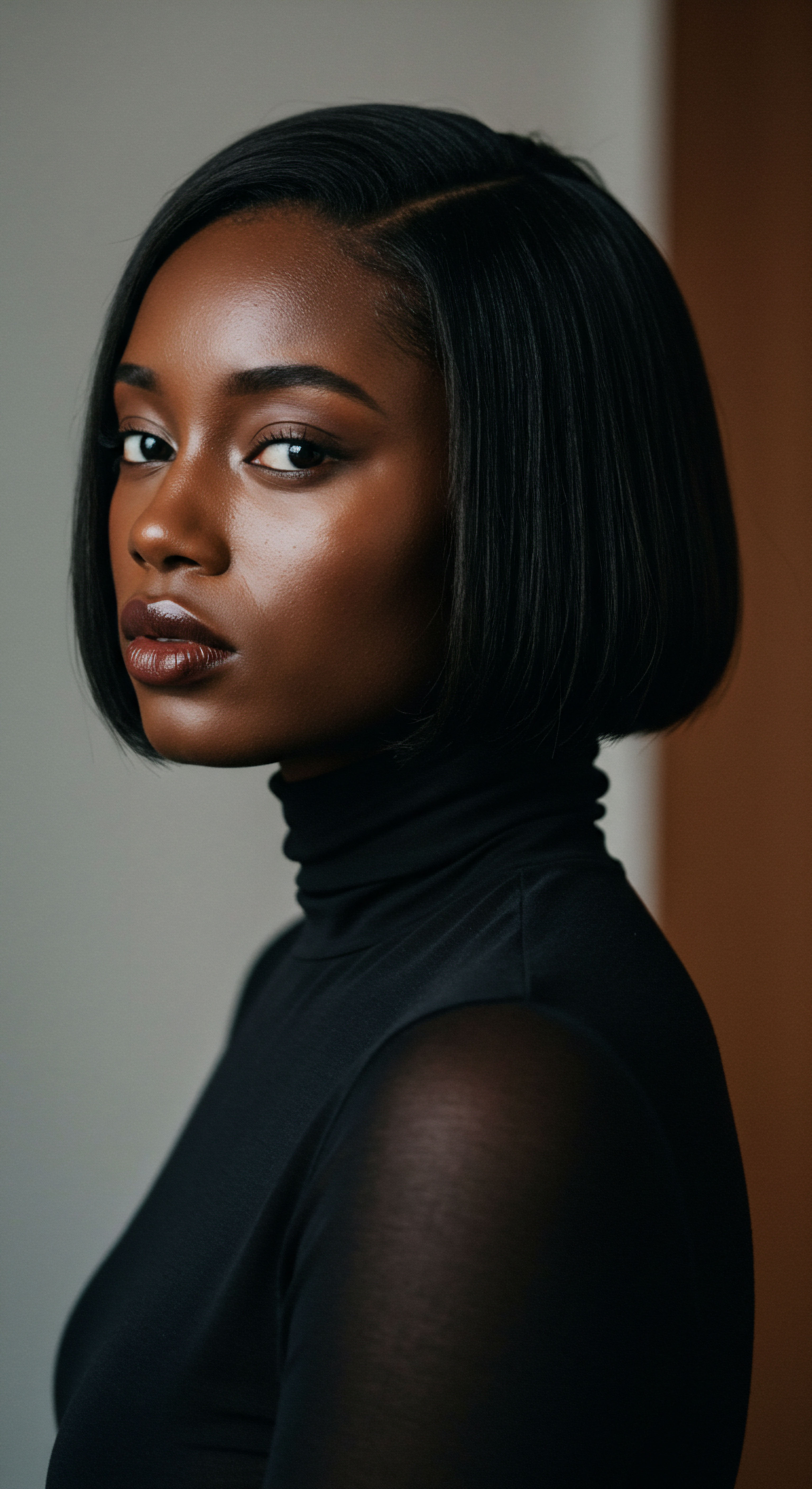
Roots
The whisper of oil through strands, a ritual as old as time, carries within it the echoes of ancestral wisdom. Long before the advent of molecular hair science, communities across continents discovered the profound connection between natural oils and the vitality of their hair. From the shea butter of West Africa to the coconut oil of the Pacific Islands, and the intricate herbal concoctions of Ayurvedic traditions, these practices were never merely cosmetic.
They represented a deep, intuitive understanding of hair’s needs, passed down through generations, often intertwined with cultural identity and rites of passage. What secrets do these ancient ways hold for our modern understanding of textured hair, particularly as contemporary science offers its own precise insights?

The Hair’s Ancient Architecture
At its heart, hair, especially textured hair, is a complex biological marvel. Each strand, a delicate protein filament, possesses a unique architecture. The outer cuticle, a protective layer of overlapping scales, guards the inner cortex, which gives hair its strength and elasticity. For textured hair, the cuticle layers often lift more readily, making it susceptible to moisture loss and dryness.
This inherent characteristic likely informed the earliest oiling practices, which sought to seal, protect, and lubricate the hair shaft. Traditional oiling, in its most fundamental sense, was a response to this structural reality, a protective shield against environmental stressors and daily manipulation.
Traditional oiling practices represent an intuitive, ancient response to hair’s fundamental need for protection and moisture retention.
Consider the widespread use of Coconut Oil in many tropical regions. Its molecular structure, rich in lauric acid, allows it to penetrate the hair shaft more deeply than many other oils, reaching the cortex. This deep penetration can help reduce protein loss, a common concern for textured hair which can be prone to breakage.
A study published in the Journal of Cosmetic Science highlighted coconut oil’s unique ability to mitigate protein loss for both damaged and undamaged hair when used as a pre-wash or post-wash treatment. This empirical finding from modern research lends scientific credence to centuries of traditional use, illustrating how ancestral practices often held a truth that science later uncovers.

Elemental Hair Nourishment
Traditional oiling was not a singular act but a spectrum of applications, each serving a distinct purpose. Some oils, like Castor Oil, were favored for scalp health and promoting hair density, while others, such as Argan Oil, were prized for their ability to add shine and softness to the strands. The understanding of these oils was experiential, learned through observation and inherited wisdom. The choice of oil often depended on local availability and the specific hair concern being addressed, creating a rich tapestry of localized hair care wisdom.
- Scalp Stimulation ❉ Many traditional practices involved massaging oils into the scalp, believed to improve circulation and promote healthier growth.
- Moisture Retention ❉ Oils formed a barrier on the hair surface, sealing in moisture and reducing evaporation, especially crucial for porous textured hair.
- Conditioning and Detangling ❉ Applied to strands, oils aided in softening and making hair more manageable, reducing friction during styling.
The core of traditional oiling rested upon the simple, yet powerful, premise of lipid application to hair and scalp. These lipids, whether from plant seeds, nuts, or animal fats, provided a tangible layer of protection and lubrication. They were the original conditioners, the first detanglers, and the earliest scalp treatments, all without the complex chemical formulations of contemporary products. The knowledge of which plant yielded which benefit was meticulously preserved, a testament to keen observation and intergenerational learning.

Ritual
Stepping from the foundational understanding of hair’s architecture, we now turn to the daily or periodic practices that shape our hair’s vitality. The act of oiling, once a quiet, unhurried ritual, contrasts sharply with the swift, targeted application often characteristic of modern hair science. Yet, within both approaches, a shared goal remains ❉ to bestow health and beauty upon our strands. How do these distinct approaches, one rooted in tradition and the other in laboratory precision, truly compare in their practical application?

The Hands-On Approach of Traditional Oiling
Traditional oiling practices often involved generous application, a meditative massage, and a patient waiting period. It was a sensory experience, often performed with warmth, perhaps by a parent or elder, deepening its significance beyond mere hair care. The oils were typically unrefined, raw, carrying the full spectrum of their natural compounds. They might be infused with herbs, heated gently, or blended with other natural ingredients to create personalized concoctions.
The focus was on saturation, allowing the oil to deeply coat the hair and nourish the scalp over hours, or even overnight. This method, while seemingly simplistic, provided a consistent lipid barrier, aiding in moisture retention and reducing mechanical damage during daily styling.
| Aspect Application Method |
| Traditional Oiling Generous, often massaged into scalp and strands; prolonged contact. |
| Modern Hair Science Targeted, precise application; often rinse-out or leave-in. |
| Aspect Product Composition |
| Traditional Oiling Unrefined natural oils, herbal infusions, whole ingredients. |
| Modern Hair Science Refined oils, synthetic compounds, active ingredients, emulsifiers. |
| Aspect Primary Goal |
| Traditional Oiling Protection, lubrication, scalp health, cultural practice. |
| Modern Hair Science Specific problem-solving (e.g. frizz, breakage), cosmetic finish. |
| Aspect Understanding of Hair |
| Traditional Oiling Experiential, observational, generational wisdom. |
| Modern Hair Science Molecular, biochemical, microscopic analysis. |

Precision and Formulation in Modern Hair Science
Modern hair science, by contrast, operates with a microscopic lens. It dissects the hair strand, identifies specific deficiencies, and formulates solutions with targeted active ingredients. Instead of simply applying oil, modern products often contain a complex blend of emollients, humectants, proteins, and specialized silicones, each chosen for its precise function.
For textured hair, this might mean a conditioner with specific cationic surfactants to smooth the cuticle, or a leave-in treatment with hydrolyzed proteins to strengthen the cortex. The focus shifts from general lubrication to molecular intervention, aiming for measurable improvements in hair elasticity, tensile strength, or surface smoothness.
Modern hair science prioritizes targeted molecular intervention, whereas traditional oiling often centered on broad protection and lubrication.
Consider the contemporary understanding of Hair Porosity. Textured hair often exhibits high porosity, meaning its cuticle layers are more open, allowing moisture to enter and leave easily. Modern science addresses this with products containing film-forming ingredients or specific polymers that can help seal the cuticle and reduce moisture loss.
While traditional oils certainly contributed to this sealing effect, modern formulations can offer a more controlled and often lighter film, designed to avoid product build-up while maximizing moisture retention. This precise engineering of ingredients marks a key distinction in the practical application of modern hair science.

Are the Approaches Mutually Exclusive?
The divergence in approach raises a question ❉ must we choose one over the other? A harmonious integration of both traditional wisdom and scientific advancement presents a compelling path. Modern science can validate and refine traditional practices, explaining why certain oils worked so well. Conversely, traditional methods can remind us of the beauty of simplicity and the power of consistent, gentle care.
For textured hair, this could mean using a traditional oil pre-poo treatment to protect strands before cleansing, followed by a scientifically formulated conditioner designed to address specific porosity needs. The practical wisdom of tradition, combined with the analytical rigor of science, offers a comprehensive approach to hair wellness.

Relay
We stand at a unique intersection where ancestral practices meet cutting-edge discovery. This convergence invites a deeper, more reflective sub-question ❉ How do the long-held cultural significance and holistic benefits of traditional oiling intersect with the granular, empirical evidence provided by contemporary hair science, particularly for textured hair? This section will venture beyond surface-level comparisons, seeking the profound connections and subtle divergences that truly shape our understanding of hair care.

Beyond the Visible ❉ Microscopic Impact
Traditional oiling, often viewed as a surface-level conditioning treatment, exerts a more profound impact on the hair structure than might be immediately apparent. The regular application of lipids helps to maintain the Hydrophobic Nature of the hair surface, which is crucial for preventing excessive water absorption and subsequent cuticle swelling. This swelling and deswelling cycle, particularly prevalent in highly porous textured hair, can lead to Hygral Fatigue and increased breakage. By creating a consistent lipid layer, traditional oils effectively mitigate this stress.
A significant area of modern research has focused on the specific molecular interactions of oils with hair. While many traditional oils provide surface lubrication, certain oils, due to their fatty acid composition, can penetrate the hair shaft. For example, studies have shown that oils rich in Saturated Fatty Acids, such as coconut oil, can diffuse through the cuticle and into the cortex.
This internal lubrication can reduce friction between protein fibers within the hair, thereby lessening damage from mechanical stressors like combing and styling. This microscopic interaction provides a scientific underpinning for the centuries-old observation that regular oiling improves hair strength and resilience.

The Scalp Microbiome ❉ A New Frontier
Traditional oiling practices frequently involved scalp massage, often with medicated or herb-infused oils. This practice was intuitively understood to promote hair growth and alleviate scalp conditions. Modern science is now beginning to unravel the complexities of the Scalp Microbiome – the delicate ecosystem of microorganisms residing on the scalp. A balanced scalp microbiome is increasingly recognized as a cornerstone of healthy hair growth and scalp health.
Some traditional oils possess Antimicrobial Properties. For instance, tea tree oil, often incorporated into traditional remedies, has demonstrated efficacy against certain fungi and bacteria. While modern medicine might prescribe specific antifungal or antibacterial agents, traditional oiling offered a broader, gentler approach to maintaining scalp equilibrium.
The regular application of oils, especially those with anti-inflammatory compounds, could have indirectly contributed to a healthier scalp environment by soothing irritation and providing a barrier against environmental aggressors. This holistic scalp care, often a central tenet of traditional practices, is now being validated by emerging research into the intricate relationship between the scalp’s microbial community and hair follicle function.

Cultural Continuity and Psychological Well-Being
Beyond the biophysical effects, the cultural and psychological dimensions of traditional oiling cannot be overstated. These practices are often deeply embedded in Cultural Identity, serving as a link to heritage and community. The act of oiling can be a moment of self-care, a bonding ritual within families, or a public expression of cultural pride. This psychosocial benefit, while difficult to quantify with scientific metrics, profoundly impacts overall well-being and, by extension, the perception of hair health.
The interplay of traditional oiling’s cultural depth and modern science’s empirical precision offers a truly holistic view of hair care.
In contrast, modern hair science, while highly effective in addressing specific hair concerns, sometimes risks divorcing hair care from its broader cultural and personal context. The focus on efficacy and quick results can overlook the slower, more meditative aspects of hair care that contribute to a sense of peace and connection. A truly integrated approach acknowledges both the scientific advancements that allow for targeted problem-solving and the profound, often unspoken, benefits derived from practices rooted in tradition and cultural continuity. This means not just understanding what an ingredient does at a molecular level, but also what it means to the individual and their heritage.
Consider the historical use of Chebe Powder by the Basara Arab women of Chad. This traditional mixture, often combined with oils, is renowned for its ability to prevent breakage and promote length retention. While scientific studies on Chebe powder are still emerging, the anecdotal evidence and centuries of cultural practice speak volumes. Modern science could dissect its components, identifying specific proteins or lipids that contribute to its efficacy.
Yet, the ritual of its application, the shared knowledge among women, and its role in defining beauty within that community, are aspects that transcend mere chemical analysis. The relay of knowledge, from ancient wisdom to contemporary labs, reveals that true hair wellness encompasses both the visible strand and the unseen layers of culture and spirit.

Reflection
The journey from ancestral oiling practices to the precise formulations of modern hair science is not a linear progression from primitive to advanced, but rather a spiraling ascent of understanding. Each approach, with its distinct lens, reveals different facets of hair’s complex needs. Traditional methods, steeped in intuitive wisdom and cultural significance, offer profound lessons in consistency, gentle care, and the holistic connection between self and heritage.
Modern science, with its analytical rigor and microscopic vision, deciphers the molecular dance, offering targeted solutions and a deeper comprehension of hair’s biological responses. The most luminous path forward for textured hair care lies not in choosing one over the other, but in a respectful, discerning integration—allowing the enduring warmth of tradition to guide our touch, while the clear light of science illuminates our choices.

References
- Rele, V. G. & Mohile, R. B. (2003). Effect of mineral oil, sunflower oil, and coconut oil on prevention of hair damage. Journal of Cosmetic Science, 54(2), 175-192.
- Gavazzoni Dias, M. F. R. (2015). Hair Cosmetics ❉ An Overview. International Journal of Trichology, 7(1), 2-15.
- Robbins, C. R. (2012). Chemical and Physical Behavior of Human Hair (5th ed.). Springer.
- Garg, S. & Sharma, P. (2020). Hair care practices in different cultures ❉ A review. Journal of Dermatology and Cosmetology, 4(1), 10-18.
- Draelos, Z. D. (2011). Hair care products ❉ what to tell patients. Journal of Cosmetic Dermatology, 10(2), 137-142.
- Priya, K. & Arumugam, A. (2019). A Review on Hair Care Products and their Ingredients. International Journal of Pharmaceutical Sciences Review and Research, 58(2), 1-8.
- Trueb, R. M. (2016). The scalp microbiome. International Journal of Trichology, 8(4), 163-165.